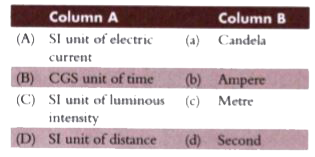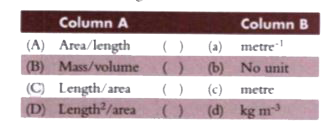Complete Solutions to TEST YOUR CONCEPTS (SHORT ANSWER TYPE QUESTIONS) of chapter MEASUREMENTS AND MOTION of Class 6 book with complete answers and questions
| Class 6 | PHYSICS |
| Chapter | MEASUREMENTS AND MOTION |
| PEARSON IIT JEE FOUNDATION | TEST YOUR CONCEPTS (SHORT ANSWER TYPE QUESTIONS) |
| Number Of Questions | 56 |
| Academic Year | 2023-24 |
Define physical quantity and give any two examples.
View SolutionDefine derived physical quantity and give any two examples.
View SolutionDefine multiple units.
View SolutionDefine unit and write any three examples.
View SolutionDefine fundamental unit and write any two examples.
View SolutionWhat is the SI unit of the ratio of mass to area?
View SolutionWrite the correct notation for the following.
(a) 2 Kg
(b) 4 Newtons
(c ) 6 metres
(d) 35 Gram
(e) 7 S
View SolutionWrite the correct notation for the following.
(a) 2 Kg
(b) 4 Newtons
(c ) 6 metres
(d) 35 Gram
(e) 7 S
View SolutionWrite the correct notation for the following.
(a) 2 Kg
(b) 4 Newtons
(c ) 6 metres
(d) 35 Gram
(e) 7 S
View SolutionWrite the correct notation for the following.
(a) 2 Kg
(b) 4 Newtons
(c ) 6 metres
(d) 35 Gram
(e) 7 S
View SolutionWrite the correct notation for the following.
(a) 2 Kg
(b) 4 Newtons
(c ) 6 metres
(d) 35 Gram
(e) 7 S
View SolutionMatch the entries in Column A with entries in Column B.

View SolutionAssertion A: 1 metre can be written as 1 m and not as 1 M.
Reason R: If the unit of physical quantity is not named after a scientist, symbol of the unit should not be denoted with a capital letter.
View SolutionWrite the following steps in sequential order to convert centimetres into millimetres.
View SolutionIf the product of milli and micro is nano and the values of milli and nano are `10^(-3)` and `10^(-9)`, find the value of micro.
View SolutionIf A, B and C are the units of time, length and speed, then find the relationship between them.
View SolutionFind the units of density, `("density")/("mass")` and `("electric currect")/("time")`
View SolutionWrite the unit of the physical quantity which is the ratio of density to area.
View SolutionFind the unit of work if the work is the product of force and displacement, force = mass `xx` acceleration, where acceleration = `("length")/("time"^(2))`
View SolutionDefine length.
View SolutionDefine mass.
View SolutionDefine volume.
View SolutionDefine area.
View SolutionDefine measurement.
View SolutionFind the unit of ratio of mass to area.
View SolutionWhat is the physical quantity measured in `cm^(2)`?
View SolutionArrange the following steps in a sequence to find the area of a leaf.
(a) Find the number of complete boxes and half boxes inside the boundary.
(b) As the area of one box is 1 m^2, the total area is equal to the sum of full boxes and half boxes areas.
(c) Place it on a graph paper.
(d) Take an irregular shaped leaf.
(e) Draw the outline and remove it from the graph paper.
View SolutionMatch the following.

View SolutionAssertion (A): `m^(2)` is a derived unit.
Reason (R ): Area is a derived quantity.
View SolutionPavan is measuring the area of a leaf by using a graph paper and he measured the sum of the areas of full boxes and more than half boxes inside the outline of the leaf which is 25 `cm^(2)`. Find the length of the square whose area is equal to the area of the leaf.
View SolutionRam measured the length of a curved line using a thread. He made a right angled triangle, of base 10 cm and height 20 cm, with the same thread. Find the length of the curved line measured by him.
View SolutionConvert the unit of ratio `("mass "xx" area")/("volume")` from SI system to CGS system.
View SolutionAbhi who is interested in physics measured the volume of an irregular shaped body with concepts given by his physics teacher. When he immersed the given body in water contained in a measuring jar, the level of water is increased from 500 ml to 1500 ml. Find the volume of the body and also find the length of the edge of the cube whose volume is equal to the volume of the given irregular shaped body.
View SolutionFind the area of a coloured paper used to stick to a sphere of radius 7 cm.
View SolutionDefine time.
View SolutionDefine temperature.
View SolutionMatch the following.

View SolutionAssertion (A): Temperature is a fundamental quantity in SI system.
Reason (R ): In other systems of measurement only mass, length and time are fundamental quantities.
View SolutionWrite the following steps in a sequential order to find the time at a given instant by using a clock.
(a) Observe the position of the hour hand.
(b) Observe the position of the minute hand.
(c ) Multiply 1 hour with the number at which the hour hand is located.
(d) Note the number of minutes, considering the gap between two numbers of clocks as 5 minutes.
(e) Find the time.
View SolutionRaju started a piece of work when the hours hand and minutes hand in a wall clock are at 9 and 12, respectively. He completed his work when the hours hand is at a midway between 11 and 12, while the position of the minutes hand is at 6. Find the time taken by him to do the work.
View SolutionKeshav observed that the increase in the temperature of a body is given by `T_(1) = 2t^(2)` for the first 5 minutes and `T_(2)` = 3t for the next 5 minutes, where `T_(1)`, `T_(2)` and 't' are temperatures in Fahrenheit, Celsius scales and time in minutes, respectively. If the initial temperature of the body is `20^(@)F` and the relation between the Celsius and Fahrenheit scale is, then find the temperature of the body after 8 minutes in Celsius scale.
View SolutionDefine rest.
View SolutionDefine motion.
View SolutionDefine displacement.
View SolutionDefine velocity of an object
View SolutionDefine acceleration.
View SolutionHow can you differentiate between distance and displacement?
View SolutionIf the distance covered by a body moving in a circular path of radius (r ) is equal to `2pi r`, find its displacement.
View SolutionHow can you say that speed and velocity are different even through their units are the same?
View SolutionHow can you say that the tree on the earth is in a state of rest and in a state of motion at the same time?
View SolutionGive any one example in which a body travels with retardation and give a reason for the same.
View SolutionA particle is movingin circular path of radius 7 cm. Find the ratio of its displacement to the distance covered after the completion of a half
View SolutionFind the minimum speed required by a person standing 5 m behind a bus, to catch the bus in one minute which is moving at a speed of 600 m `min^(-1)`.
View SolutionIf a bus moves from A to B and comes back to A, find the displacement and velocity of the body.
View SolutionWhat is the speed of a body if it covers a distance of 20 m in 4 seconds?
View SolutionFind the acceleration of the car, if it changes its velocity from `20 m s^(-1)` to `30 ms^(-1)` in 5 seconds.
View Solution
TEST YOUR CONCEPTS (SHORT ANSWER TYPE QUESTIONS) questions and complete solutions for chapter MEASUREMENTS AND MOTION of PEARSON IIT JEE FOUNDATION of Class 6